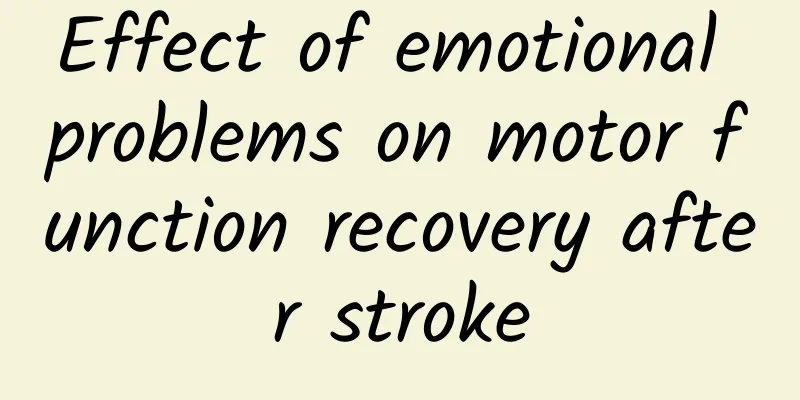Effect of emotional problems on motor function recovery after stroke

|
I believe that many clinical workers and patients' families will find it easy to find that stroke patients will have emotional and psychological problems, such as persistent depression, irritability, excessive fear during activities, etc. Some people may think that compared with the disease itself, these psychological problems are minimal or not worth paying attention to. Is this really the case? In fact, the incidence of such problems is relatively high and can occur in various periods after a stroke, causing great harm to patients and having a significant negative effect on the recovery of neurological function, seriously affecting the recovery of neurological function. 1. What are the manifestations of emotional and psychological problems in stroke patients? The psychological stages of stroke patients can be divided into 4 stages: 1. Initially, it is a period of shock and denial: patients are caught off guard by the sudden symptoms, have too high expectations for rehabilitation treatment, and have relatively mild sadness, pessimism, and depression, and are more passive in accepting rehabilitation treatment.
3. Depression: The patient is depressed, frustrated, helpless or even desperate, with early awakening, weight loss, suicidal ideation, etc. At the same time, it may be accompanied by cognitive impairment, such as decreased memory and attention, somatic symptoms such as nausea, abdominal distension, palpitations, post-stroke fatigue, pain, etc., and even psychotic symptoms. 4. Adaptation period: Acknowledge and accept reality, give up fantasies, be more positive about rehabilitation training, and depression will be alleviated or disappear. In addition, during any of the above periods, some patients are extremely afraid of exercising, afraid of falling, and dare not stand or walk due to past experiences, surrounding environment, personality traits, lesion location and other factors, which seriously affects the recovery of motor function. 2. How to identify and screen psychological problems after stroke? Psychological problems after stroke require early screening, frequent screening, and early treatment. Early identification can be achieved by observing the following risk factors. (1) Clinical risk factors include: age, gender, course of disease, medical history, family history, etc.; (2) Neuroimaging risk factors include: lesion location, lesion size, number, etc.; (3) Social factors include: personality traits, social functions, social and family role changes, social support, social and family environment, etc. Risk factors for post-stroke patients should be assessed, including post-stroke survival status, functional dependence, cognitive impairment, previous history of depression, and ability to take care of themselves in daily life. If there are two or more risk factors, psychological problems are likely to occur. Stroke patients who are positive in the above screening need to go to a specialist for a scale assessment to determine the severity of the symptoms and guide clinical diagnosis and treatment.
3. What impact do emotional and psychological problems have on rehabilitation training? Anxiety, depression, and fear (i.e., poor psychological adaptability) are the most common emotional changes. Among them, anxiety and depression mainly affect active participation in exercise. Patients are often subjectively unwilling to exercise, or are restless and irritable during rehabilitation training, and cannot cooperate well with treatment. Fear has a greater impact on motor recovery. Patients are extremely afraid of falling when standing or walking, and they are extremely afraid psychologically, which manifests as facial tension, increased heart rate, increased blood pressure, sweating, the urge to defecate, pain, etc., which seriously affects the recovery process and daily living ability.
(1) Patients who show symptoms of anxiety and depression can relieve their symptoms through psychological counseling, psychological communication, medication, etc. (II) Fear during exercise (poor psychological adaptability) requires special attention to the following points: (1) Family members around the patient should encourage the patient. Encouragement, comfort, praise, and affirmation are positive effects; (2) Communication through words, eye contact, and body language will all have an impact on the patient. Special attention should be paid to not hint at any "exercise risk" when communicating with the patient, such as saying "be careful not to fall" in front of the patient. (3) No one should ever say to the patient "your bad leg" or other similar words at any time, which will constantly remind the patient that there is something wrong with the limb, thereby increasing the patient's lack of confidence in their own functions. (4) Controlling psychological adaptability during exercise is the key to solving the problem. First of all, patients should not be forced to stand up to exercise, walk, etc., nor should they be forced to accept exercises that they cannot complete. Therefore, the following points should be considered in the treatment and daily care of patients with post-stroke psychological fear: 1) Whether the patient accepts the treatment; 2) Focus on the patient's emotional and psychological reactions during treatment and find appropriate treatment methods that adapt to the patient's psychological state; 3) Assess whether the items (appearance, comfort, etc.) and places (PT hall, ward, outdoors, community, etc.) needed for treatment are appropriate, provide support or assisted exercise when necessary, and gradually remove assistance; 4) Try to distract the patient during exercise (reduce excessive alertness during exercise and improve sports fear); 5) Carry out step-by-step according to the goal, provide timely feedback and make timely adjustments. When conducting dynamic emotional psychological assessment, the following observations can be completed during rehabilitation training: facial expressions, eye contact; sweating; changes in blood pressure, heart rate and breathing; language expression; body language such as grip performance; body posture and tension; stability; attitude towards the target task (positive/confident/fearful/resistant). In addition, imaging assessments can be performed through connection groups, EEG detection and other equipment. It is important to pay attention to emotional and psychological problems after stroke, conduct early screening, early detection and early treatment to promote patients' functional recovery and return to their families and society.
——Dr. Trudeau’s epitaph Image source: https://www.pexels.com/zh-cn/ https://pixabay.com/en/ Author: Zhan Weiyi (Department of Rehabilitation Medicine, Provincial Hospital of Jiangsu Province) Reviewer: Zhang Lixia (Director of the Rehabilitation Medicine Department of the Jiangsu Provincial Government Hospital, Standing Committee Member of the Rehabilitation Treatment Committee of the Chinese Rehabilitation Medicine Association) |
<<: How to choose children's corrective glasses? How to wear them?
Recommend
What are the symptoms of thin endometrium?
With the rapid development of social economy, peo...
Is it a good omen for a woman to dream of a dead snake?
Snakes need to hibernate in winter, and some snak...
What causes itchy breasts during pregnancy?
In the early stages of pregnancy, because the pro...
Symptoms of frozen shoulder in women
Because periarthritis of the shoulder is more com...
How to make bayberry wine taste good? What are the effects of bayberry wine?
In the midsummer, drinking bayberry wine will make...
How to care for cesarean section wound
During the final period of delivery, pregnant wom...
What causes fetal heart rate to stop developing?
At around 7 weeks of pregnancy, the fetal heartbe...
What should I do if a girl's period is delayed for more than ten days?
Whether the menstrual period is normal is closely...
Hormones cause obesity?! You are wrongly blaming it!
When a doctor tells you that you need to take a c...
What causes breast tenderness after ovulation?
The breast is an important and sensitive reproduc...
Breastfeeding takes the whole family
Author: Zhou Ying, Peking Union Medical College H...
What is the difference between blood oranges and navel oranges? Which one is more nutritious?
The flesh and juice of fresh blood oranges are da...
Does a woman's body temperature rise during ovulation?
During the period of ovulation in girls, there wi...
Why do girls' nipples get bigger?
Generally speaking, the phenomenon of enlarged ni...
What to do with women's lip hair
Most people are born without body hair, but as pe...









